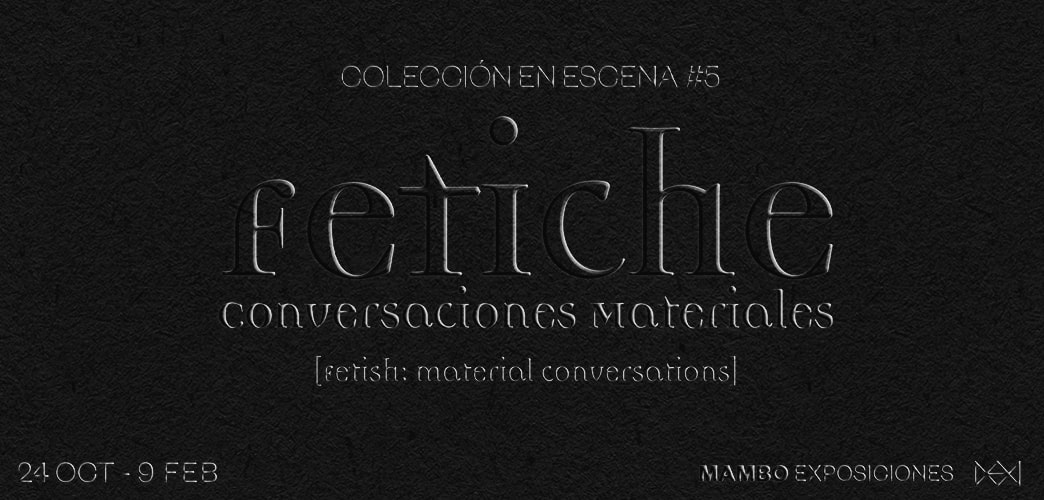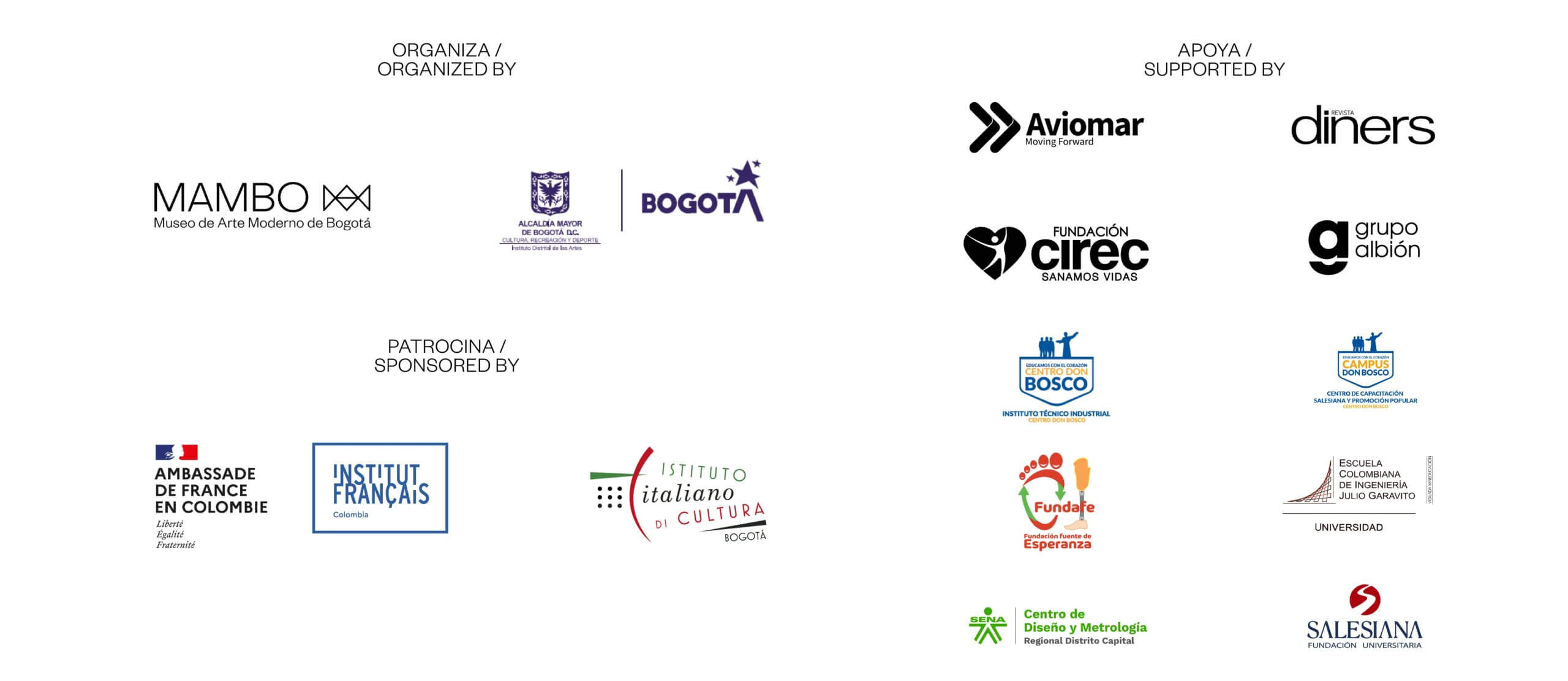
— 09.02.2025
Collection on Stage #5. Fetish: Material Conversations
Collection on stage #5: Fetish: material conversations presents a selection of works from the Museum of Modern Art of Bogotá’s Collection, which not only represent an important part of the nation’s artistic and cultural heritage but also come together to construct a network of meanings around the concept of the ‘fetish.’
Divided into five main axes, the ‘fetish’ is conceived as an umbrella term encompassing ideas and objects on the margins of the norm, what is accepted, or what is rational. Whether seen as a synonym for a religious idol, an object of excessive sexual desire, or an element of socially perceived value, the ‘fetish’ brings together, under a single concept, the limbo between devotion and materiality, desire and power, magic and artifice, totem and amulet, the social construction of value, and its individual appreciation. Thus, this exhibition invites reflection on our relationships with the materiality that surrounds us.
- The exhibition contextualizes over 35 works under the categories of ‘Gazing into the Void,’ ‘Astrality – Ancestrality,’ ‘Alchemy,’ ‘Animism/Spiritualism,’ and ‘Passion/Drive.’
- Each section navigates the concept of the ‘fetish,’ a word with diverse origins in Latin, African pidgin, Portuguese, and French. It can be understood as a desire, attraction, or excessive veneration toward an object or person. Additionally, the term carries philosophical, social, erotic, and religious dimensions that still present tensions in the contemporary world.
- The show brings together the works of renowned modern and contemporary artists to establish dialogues that, although embedded in artistic currents marked by rationalism and skepticism—characteristics of modern art—approach the creative act through the drive of the esoteric, the hidden, and the ancestral.
- Collection on stage #5 is the fifth in a series of exhibitions that seeks to research, preserve, disseminate, and make accessible the Museum’s collection. The main objective is to build alternative discourses that allow for interpretations of the works beyond their visual narratives, enriching traditional chronological accounts with innovative concepts and themes.
- Collection on stage #5: Fetish: material conversations highlights works from the Intercol Salons, Athens Salons, and the Bogotá Biennials, those exhibitions spearheaded by MAMBO that not only introduced new names to the art scene but also incorporated experimental, hard-to-classify approaches.
The exhibition weaves together works categorized under five concepts, which intersect in each piece. ‘Gazing into the Void’ represents artistic formal explorations related to the concept of infinity, or the perpetuity of absorbed fullness. Through two-dimensional works, with flat colors and abstract figures, this section allows the departure from narrative as an irreducible act of mediation in today’s reality.
Similarly, the sacred guidance of the stars has inspired spiritual solutions, social organizations, religions, and even geographic references since the beginning of human history. The idea of ‘Astrality – Ancestrality’ legitimizes human concerns, evidencing connections with the celestial and the primordial, and approaches, through mysticism, the figures and archetypes inherited from the past.
Through materials like glass, steel, marble, or iron, or supported by liquid, fragile, or unbreakable mediums, ‘Alchemy’ trusts in the element’s capacity for dialogue, in the conviction that simple form transmutes with each incarnation. This medieval occult discipline, practiced in Europe, China, and the Middle East, operated under the belief in the transmutation of matter and the possibility of converting any element into precious metals.
With the belief that all objects—natural, such as mountains, rivers, and animals, as well as cultural, like technological and everyday items—have life as long as they have a soul, ‘animism’ and ‘spiritualism’ serve as references to understand how the immaterial dimensions of the universe, inhabited by intangible entities, can influence the material dimension we know, inhabited by tangible bodies.
Finally, the ideas of ‘Passion/Drive’ reveal the inherent tension between the realms of the natural and the social, while creating a space to question our own prejudices and perceptions about the passionate impulse. Aiming for a complete panorama that transcends the carnal exploration of sexuality and desires, this category invites an introspective and revelatory journey into the new dimensions that have remained hidden within ourselves.
The participating artists in the exhibition are: Susana Amundaraín (1958), Germán Botero (1946), Mauricio Calixto (1968), Antonio Igninio Caro (1952 – 2022), Francisco Klinger Carvalho (1966), John Castles (1946 – 2023), Marta Combariza (1955 – 2022), Leonel Góngora (1932 – 1999), Heinz Goll (1934 – 1999), Fabio González (1952), Álvaro Diego Gómez Campuzano (1956), Enrique Grau (1920 – 2004), Carlos Herrera (1976), Pedro Alcántara Herrán (1942), Luz Lizarazo (1966), Luis Luna (1958), Roberto Matta (1911 – 2002), Norman Mejía (1938-2012), Ana Claudia Múnera (1966), Sara Modiano (1951 – 2010), Armando Montoya (1956), Nadín Ospina (1960), Julián Posada (1963), Raquel Rabinovich (1929), Ofelia Rodríguez (1946 – 2023), Carlos Rojas (1933 – 1997), Carlos Torres (1955), Ronny Vayda (1954), Pablo Van Wong (1957 -2013), Hugo Zapata (1945) y Luis Fernando Zapata (1951 – 1994).

Curatorship: Juaniko Moreno: Curator and researcher interested in cosmotechnics, language and information, nature/culture divide, and art and sustainability projects. He holds a Master’s degree in Fine Arts from the National University of Colombia, and a Master’s in Contemporary Art and Curatorial Studies from the China Academy of Art, in Hangzhou. He was part of the research think-tank The Terraforming 2021 at the Strelka Institute, and currently works as a professor in the Fine Arts Program at the Universidad del Bosque and as a junior curator for the Museo de Arte Moderno de Bogotá – MAMBO.

